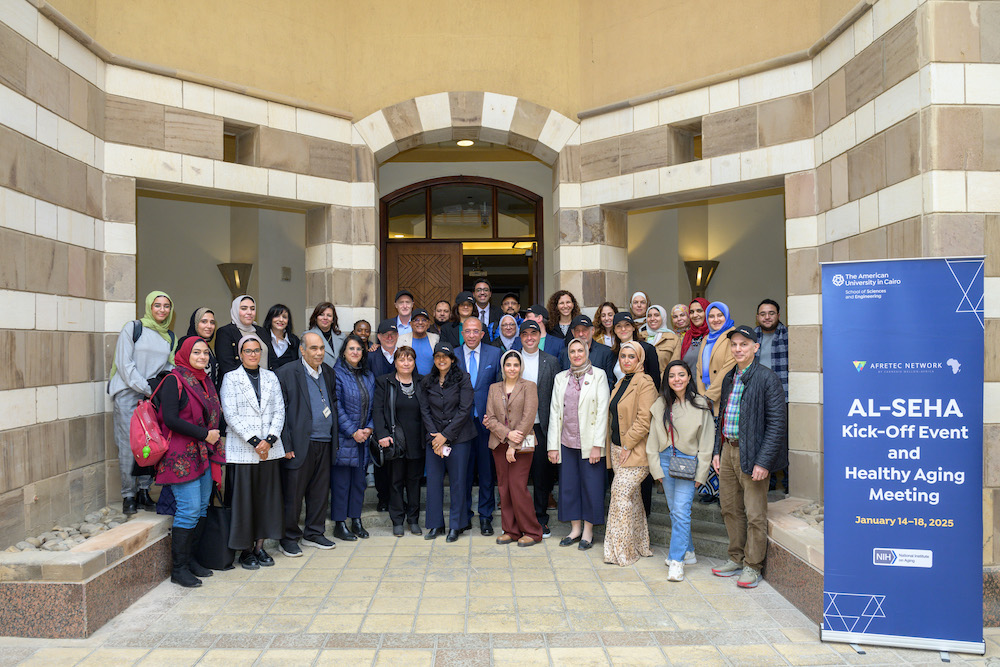Understanding longevity: From gene sequences to social inequity
03 April 2025
Published online 3 April 2025

Photo credits: AUC.
Ageing is a complex area of global research, yet many countries are underrepresented in studies. In the Middle East, rapid demographic shifts, coupled with unique factors such as high rates of consanguineous marriages, social and economic inequalities, and gender divides, present particular challenges and opportunities for ageing research.
With the recent launch of two major studies—AL-SEHA in Egypt and LSAHA in Lebanon—, ageing research in the Middle East is entering a new era, promising to fill a long-standing regional research gap, and also to enrich global knowledge about ageing.
These regional insights are essential pieces in the global puzzle of ageing research, which seeks to understand why we age, when is the starting point of decline, and how can we reverse this process.
The complex puzzle of ageing
While there are deep complex layers affect ageing; including biological, environmental, and social aspects, researchers used to work in silos, focusing on separate tracks. Biological research prioritized genetics and epigenetics, environmental research focused on pollution, while social studies tried to understand the inequities that accompany getting older.

Biological research has enriched our understanding of the ageing process, the relevant factors contributing to it, and suggestion targets for slowing down, or more ambitiously, reversing it.
Despite this progress in biological research, there have been always missing pieces; for example, experiments on animals and cell cultures cannot be easily modeled in humans. So, while understanding the biological basis of ageing has been enriching our knowledge, biology is only one big piece of the complex puzzle of ageing.
Another piece of the puzzle is the environment that plays a significant role in affecting the ageing process. For years, environmental research focused on identifying a single exposure that can be correlated to ageing and related morbidities. However, given the complexity of human exposures, it would be unrealistic to think this way.
Exposure should involve everything humans get exposed to throughout their life. This includes identifying retrospective exposures which allow us to estimate chronic long term environmental contribution to health, and the domain of exposure that influences ageing whether it’s physical, psychological or economic. Including these areas in our evaluation of environment is mandatory to study the lifelong exposures that shape the way people grow old.
Interdisciplinary approach
The understanding of this big definition of environment led to the development of socio-economic surveys as a part of ageing studies. These comprehensive surveys try to explore life exposures from social and economic equity lens and derive conclusions related to the communities’ structures and how they affect the ageing process.
The comprehensive and longitudinal data collection tools have proven to be of unparalleled benefit for understanding ageing and identifying the complex network of determinants of healthy ageing.
The nature of longitudinal ageing studies is to collect the data using consecutive data collection stages, composed of healthy, normal subjects before starting the ageing process, at the age of 45 or 50. Then, the cohort will be followed up regularly for an extended period of 10 to 20 years. The subsequent waves will provide the chance to revisit the initial wave subjects and assess, in real time, what happens during ageing. Ideally, this research should start from age 0, even before birth. However, this approach is very challenging and difficult to achieve.
The concept of longitudinal cohorts of ageing combines the different factors including biological; genetics and biomarkers, social, economic, and psychological aspects among others. The use of different data collection tools spanning from extensive surveys, full medical examinations, to biological samples, cognitive assessments, provides a better understanding of the complexity of the ageing process.
International Collaborations
While longitudinal studies offer a comprehensive and interdisciplinary approach for ageing studies, international harmonization and comparability is an additional challenge. As each population has unique characteristics it's crucial to study different populations and compare between them using standardized tool, to have a clear, complete and holistic picture of ageing.
The Health and Retirement Study-Around The World (HRS-ATW) is a good example of such harmonized studies, which is composed of several worldwide longitudinal studies of ageing modeled after the Health and Retirement style that was originally started in the United States. The network of studies around the world uses standardized surveys, allowing for cultural adaptation based on local cultural and demographic contexts. This harmonization helps comparing findings and understanding effects on patterns of ageing.
Inclusion of Middle East
Inclusion is another major challenge that limits our understanding of the whole picture. Many countries are underrepresented in ageing studies, including the Middle East, which leads to data deficiency and lack of proper representation of different cultures and populations across the world.
The recent launch of AL-SEHA study in Egypt, and LSAHA study in Lebanon, contributes to the global knowledge about determinants of ageing in different populations and under diverse circumstances.
AL-SEHA is a Longitudinal Study of Egyptian Healthy Ageing that is modeled on the US Health and Retirement Study (HRS) and the Survey of Health, Ageing and Retirement in Europe (SHARE). Since Egypt represents a central region of the Middle East with a diversified population at the intersection of Mediterranean, Arab and African influences, the study will fill a significant gap in the international network of harmonized ageing studies.
AL SEHA will include 20,000 individuals aged 50 years and older. That will provide a baseline and a first follow-up wave including a community module, geocoded and environmental data. It will also employ a tested and contextually validated tool to measure the prevalence of dementia and cognitive impairment in Egypt, following the harmonized cognitive assessment protocol (HCAP).
In Lebanon, LSAHA represents a survey study of a representative sample of 3,000 residents aged 60 years and above. The survey questionnaire to the participants includes standardized questions about their personal, social, and economic background, their cognitive, physical and mental health, and their present and past life experiences.
The new initiatives aim to investigate equity, gender, and climate concerns in a context that is new for the HRS-style ageing surveys, provide rich data for the Middle East, and serve as a model for further ageing studies in the Arab speaking countries, and hopefully, both initiatives could provide a nucleus for a Pan Arab ageing study in the future.
doi:10.1038/nmiddleeast.2025.38
Stay connected: